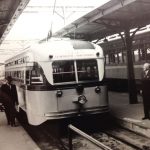LARY 1444 : Green luxury on the streets of LA
By Ralph Cantos
This 1930 view, taken at the old Division 2 just across the street from South Park Shops, nicely illustrates the new look for 35 of the Los Angeles Railway’s newest steel passenger cars. Cars 1416 to 1450 were upgraded from H-4 to H-3 “DELUXE” status in 1929-1930. The most obvious element of the upgrade was a striking new pastel green and cream paint scheme, with silver roof, a dramatic departure form the then-standard yellow and brown paint scheme of the LARY.
Other improvements to the 35 cars consisted of enhanced interior lighting installed in a new smooth head liner, new upholstered seats, and enclosing the entire car body with brass window sashes. All these expenditures were made by the LARY so as to be granted a fare increase of about 2 CENTS by the Public Utilities Commission.
About two years after going into service one last improvement was made to the H-3s in the form of the HUNTER ROLL sign box inset into the roof above the right front window, replacing the standard roof slat number box used on all LARY cars up to that time. In time, several H-4 cars in the 1200 class (OERM’s 1201 being the first H-4 to get the HUNTER ROLL sign box) and a few 1300s also got the HUNTER ROLL sign box. A nice improvement to the cars and especially for the poor LARY shop man who had to climb up the side of the cars to change the line number or letter slat on the roof box. (Something I would not look forward to doing.)
One other item of interest in this photo is that the 1444 is equipped with the standard “high eclipse fender” that was used to clear the MU coupler. When all MU operation was discontinued on the LARY, a low fender replaced the high fenders, much to the pleasure of LARY crews. The GREEN cars operating mostly on the long 5 Line lasted only about 4 or 5 years. By 1936, they were but a distant memory.
The 35 H-3s along with a handful of open H-4s lasted until late 1958, rendering thirty-five years of faithful, dependable service to the LARY, LATL and for about six months, the LAMTA. A job well done.
Ralph Cantos Collection




